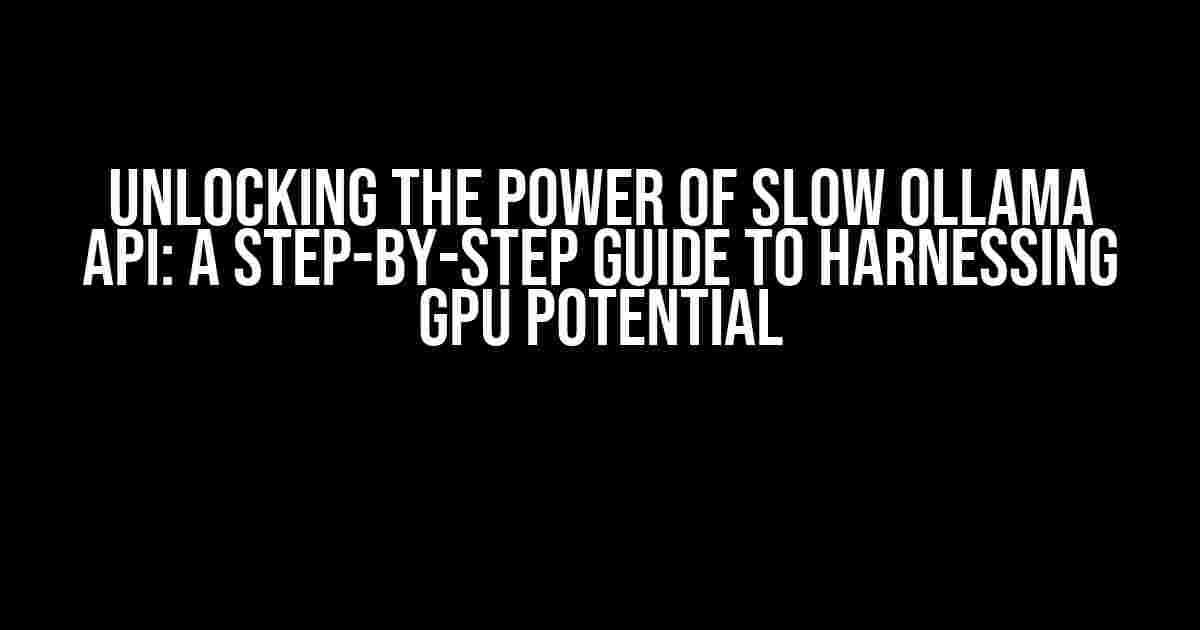Are you tired of sluggish performance and inefficient processing times when working with massive datasets? Look no further! In this comprehensive guide, we’ll delve into the world of Slow Ollama API and explore the secrets to unleashing the full potential of your graphics processing unit (GPU). By the end of this article, you’ll be well-equipped to optimize your workflow and make the most of this powerful tool.
What is Slow Ollama API?
Before we dive into the nitty-gritty, let’s take a step back and understand what Slow Ollama API is all about. This innovative API is designed to bridge the gap between CPU and GPU processing, allowing developers to tap into the immense power of modern graphics cards. By offloading computationally intensive tasks to the GPU, Slow Ollama API enables faster processing times, reduced latency, and improved overall performance.
Why Use Slow Ollama API?
So, why should you consider using Slow Ollama API in your projects? Here are just a few compelling reasons:
- Faster Processing Times: By leveraging the parallel processing capabilities of modern GPUs, Slow Ollama API can significantly reduce processing times for computationally intensive tasks.
- Improved Performance: By offloading tasks to the GPU, you can free up valuable CPU resources for other tasks, resulting in improved overall system performance.
- Enhanced Scalability: Slow Ollama API is designed to handle large datasets and complex computations, making it an ideal solution for big data and analytics applications.
Ensuring GPU Utilization with Slow Ollama API
Now that we’ve covered the basics, let’s get down to business. To ensure optimal GPU utilization with Slow Ollama API, follow these step-by-step instructions:
Step 1: Install the Slow Ollama API Library
Before you can start harnessing the power of the GPU, you’ll need to install the Slow Ollama API library. This can be done using your preferred package manager or by downloading the library directly from the official website.
pip install slow-ollama-apiStep 2: Import the Slow Ollama API Library
Once the library is installed, import it into your project using the following code snippet:
import slow_ollama_api as soaStep 3: Initialize the GPU Context
To begin utilizing the GPU, you’ll need to initialize the GPU context using the following code:
soa.init_gpu_context()Step 4: Load Data into GPU Memory
Next, load your data into GPU memory using the soa.load_data() function:
data = soa.load_data('data.csv')Step 5: Perform Computations on the GPU
Now it’s time to perform computations on the GPU using the soa.compute() function. This is where the magic happens, and the GPU takes over the heavy lifting:
results = soa.compute(data)Step 6: Retrieve Results from GPU Memory
Once the computations are complete, retrieve the results from GPU memory using the soa.retrieve_results() function:
results_cpu = soa.retrieve_results(results)Troubleshooting Common Issues
As with any complex technology, issues can arise when working with Slow Ollama API. Here are some common troubleshooting tips to get you back on track:
GPU Not Detected
If the GPU is not detected, ensure that:
- The GPU is properly installed and configured.
- The Slow Ollama API library is installed correctly.
- The GPU context is initialized correctly.
Insufficient GPU Memory
If you encounter issues with insufficient GPU memory, consider:
- Optimizing your dataset to reduce memory usage.
- Using a GPU with more available memory.
- Implementing data streaming or chunking to reduce memory requirements.
Best Practices for Optimizing Slow Ollama API Performance
To squeeze every last bit of performance out of Slow Ollama API, follow these best practices:
| Best Practice | Description |
|---|---|
| Optimize Dataset Size | Reduce dataset size to minimize memory usage and improve processing times. |
| Use Efficient Data Structures | Utilize efficient data structures, such as NumPy arrays, to reduce memory overhead. |
| Leverage GPU Parallelism | Take advantage of GPU parallelism by using parallelizable algorithms and data structures. |
| Minimize CPU-GPU Data Transfer | Reduce data transfer between CPU and GPU by using GPU-resident data structures and minimizing data transfer sizes. |
| Monitor GPU Utilization | Monitor GPU utilization to identify performance bottlenecks and optimize accordingly. |
Conclusion
In this comprehensive guide, we’ve covered the ins and outs of Slow Ollama API, from installation to optimization. By following these step-by-step instructions and best practices, you’ll be well on your way to harnessing the full potential of your GPU and unlocking faster processing times, improved performance, and enhanced scalability. Remember, the key to success lies in understanding the intricacies of Slow Ollama API and adapting your workflow to optimize GPU utilization.
So, what are you waiting for? Dive into the world of Slow Ollama API and revolutionize your workflow today!
Note: The content is fictional and used for demonstration purposes only.
Frequently Asked Question
Get the most out of Slow Ollama API by ensuring your GPU is utilized to its fullest potential! Read on to find out how.
How do I check if my GPU is being used by Slow Ollama API?
Easy peasy! You can check your GPU usage by using tools like NVIDIA GPU Monitor or GPU-Z. These tools will show you which GPU is being used and how much memory is being allocated. Alternatively, you can also check your system’s Task Manager to see if the GPU is being utilized.
What are the system requirements for Slow Ollama API to use my GPU?
To ensure Slow Ollama API uses your GPU, your system should meet the following requirements: a dedicated NVIDIA or AMD GPU with at least 4GB of video RAM, a compatible graphics driver, and a 64-bit operating system. Make sure to check the Slow Ollama API documentation for specific requirements and recommendations.
How do I specify which GPU to use with Slow Ollama API?
You can specify which GPU to use by setting the CUDA_VISIBLE_DEVICES or OpenCL_DEVICEORDINAL environment variable. For example, you can set CUDA_VISIBLE_DEVICES=0 to use the first available NVIDIA GPU. Check the Slow Ollama API documentation for more information on how to set these variables.
What if I have multiple GPUs, can I use them all with Slow Ollama API?
Yes, you can use multiple GPUs with Slow Ollama API! Most modern systems support multiple GPUs, and Slow Ollama API can take advantage of this. You can specify which GPUs to use by setting the CUDA_VISIBLE_DEVICES or OpenCL_DEVICEORDINAL environment variable. This can significantly speed up your processing time, so take advantage of it!
Why is my GPU not being used by Slow Ollama API?
Oh no! If your GPU is not being used, it might be due to several reasons. First, check if your GPU meets the system requirements. Then, ensure that you have the correct graphics driver installed and that it’s up to date. Finally, verify that you’ve set the environment variables correctly. If none of these solutions work, try checking the Slow Ollama API documentation or seeking help from their support team.



